Galeria de Mukul Banerjee (www.mukulbanerjee.com)
Hampi & North Karnataka Trip, March 10
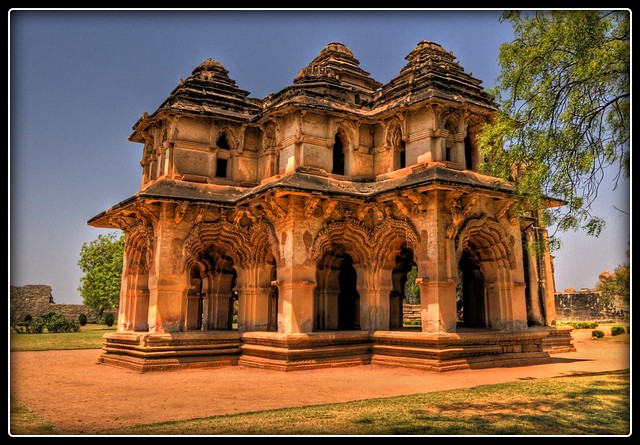
Lotus Mahal, Royal Centre Hampi
The one that needs a special mention inside the Zenana Enclosure is the Lotus Mahal. Or rather this is the highlight in Zenana Enclosure.
The style of it is a pleasant departure from the typical architecture you see in Hampi. The exact function of this is not surely known. Located inside the Zenana enclosure, most probably this was a socializing area for the women folks in the royal family.
Also known as Chitragani Mahal and Kamal Mahal, this falls under the secular or nonreligious categories of structures in Hampi. It’s peculiar to note that this is one of the beautiful structures that were left undamaged during the siege of the city. However there are some signs of mutilations on a few sculptures placed on the outer surface.
Unlike the other major structures in Hampi, this is made out of lime mortar and brick made composition.
The shape of the structure is what brought it the name. The archways and the balcony with the domed construction resemble a half opened lotus bud. Also is the lotus bud shape carved on to the center dome.
Basically this is a two storied structure with an open base floor the sidewalls are having tall arched windows. The upper floors have balconies with arched windows. Hook like structures are made on to the wall close to the windows to hang curtain. The arches of the ground floor are recessed and ornate. The decorations and architecture is a curious mix of Hindu and Islamic styles. Lotus Mahal’s Islamic style arches and the Hindu style multiplayer roof and base structure are often quoted for the ingenuity of the Vijayanagara artisans.
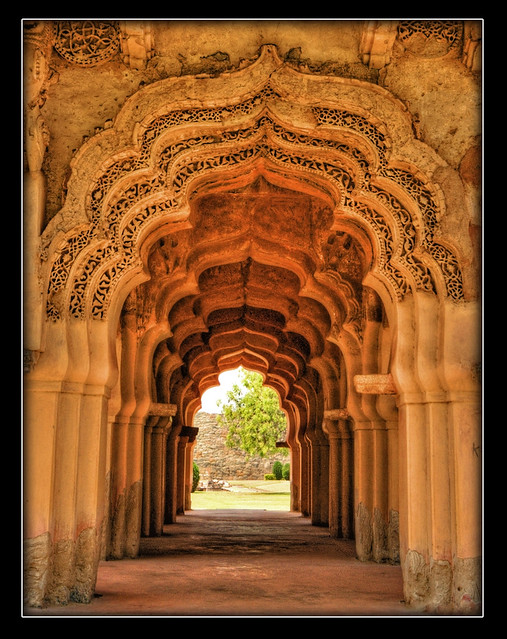
Arches of Lotus Mahal, Hampi

Lotus Mahal_1
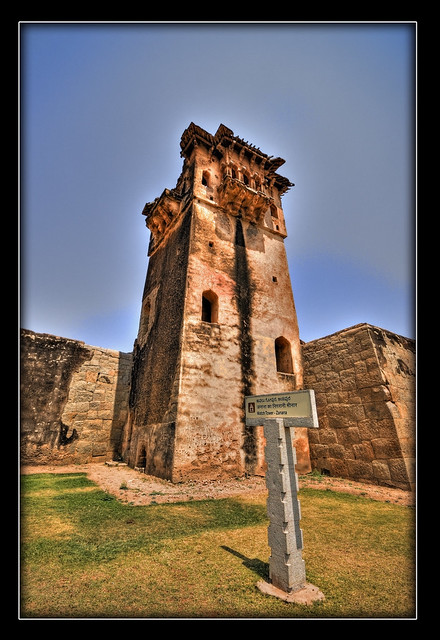
Janana Watch Tower, Hampi
Zenana enclosure was a secluded area reserved for the royal women. This walled harem houses many interesting highlights. The major attraction is the Lotus Mahal located at the southeast corner.
As the name suggests, you would enter into a sprawling compound with a mud road running through the middle of the compound. Probably the only thing you eyes catch soon when you are inside is the pastel colored Lotus Mahal at the far right corner. It’s a two-storied arched pavilion.
The whole area was the private enclosure for the royal women folks. The Queen’s Palace (visible only the basement) is located at the middle of this area, on the left side of your path. Measuring about 46 x 29 meters, this has been the largest palace base excavated in the Hampi ruins so far. Also the three-tired elaborate base structure speaks of its importance as a palace. The super structure was made of wooden or less durable materials compared to the stone base. Along with the other royal structures, a gut during the rival incursion could have destroyed the palace. A rectangular deep tank (now empty) just at east of this probably used as a water source to the palace.
Opposite to the palace base, across the central path, at the east lie the remains of a water pavilion. This is basically a decorated platform at the center of a shallow pool. This low laying spot is the first you would visit once inside the enclosure.
Three watchtowers can be seen at the corners of the enclosed area. You can spot these two storied towers close to the southeast, northeast and northwest corners. These again were built in the hybrid Indo-Islamic architecture style. Being the ladies quarters, it has been said that eunuch solders guarded the area. It’s possible to climb to the top floor of one of these towers (if very crowded, the guards may not allow this). It’s a vantage position to survey this area and the Elephant stables behind the Zenana Enclosure.
It’s Interesting the royal Treasury building too was located in this enclosure. At the northwest corner you can spot an otherwise featureless rectangular building. Some believes that it was the quarters of the eunuch guards protected this area. The structure has a simple entry at the east. A corridor runs all around inside with arches at regular intervals. The absence of windows and light inside makes it believe that this was at the best a kind of store rather than a living space.
There are the traces of a number of unnamed structures and a separation walls inside the campus.
The whole Zenana enclosure is encircled with a tall and broad walls made out of cut stones arranged in interesting patterns. The construction style of the wall is noteworthy.The enclosure had been strategically designed for the women folks to watch the royal ceremonial functions or the march past in privacy.
However there is another school of archeologists who believe this was never used as the women’s area. The archeologists assigned the names (Zenana Enclosure, Lotus Mahal etc) arbitrarily than based on some assumptions. The closeness of the nearby structures (the elephant stables, the guards quarters etc) suggests this was not a harem. They believe the Lotus Mahal as a council room for the chief commanders rather than the women’s pavilion; the rectangular enclosed building at the northwest corner as the armory or mint or treasury rather than the quarters for the eunuch guards; and the palace belonged to the king.
The path to the other locations like the Elephant Stable, Guard’s Quarters and a few other temples’ runs through the center of this area. The whole area is now made into a sort of open garden with sprawling lawns. You can see people take nap under the trees in the noontime. A good site map too is located in this area, if you need to (you will need to!) reassure your location and the next direction.
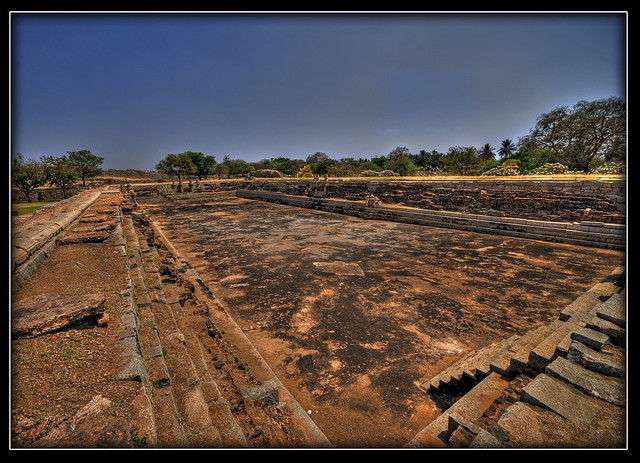
Public Bath Area, Royal Centre Hampi
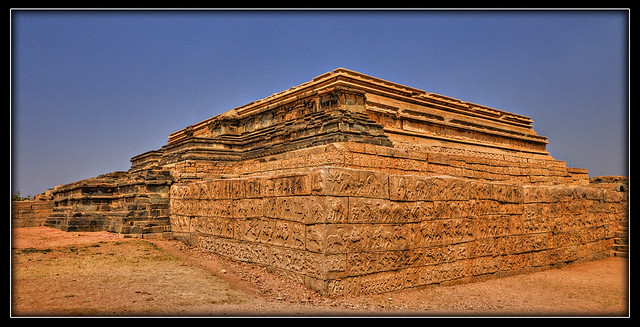
Mahanavami Dibba, Hampi
This is the tallest structure in this area and hence the first thing you would notice as you enter the Royal Enclosure. From a distance this looks like an ordinary elevated square stage. As you go close, the details emerge. The whole structure is made as a giant square structure in three layers.
There are mainly two stairways to reach the top. The front one (east facing) is highly decorated on either sides with carvings of elephants, horses and a host of other things. On the top there is nothing special to see except the great views on the campus around it. At the back of the platform a twin staircase is located. Probably this was used as a service staircase during the ceremonies. Generally one climb up through the front stair & get down through the rear, though there are no restrictions.
The sides of this three layered platform is basically fluted design with chains of sculptures (largely of elephants one behind the other). The most celebrated of the carvings are of the panels at the sidewall in the bottom portion. These dexterously carved sculptures and ornamentations depict any thing from the royal ceremony to the city life to the erstwhile foreign envoys to the kingdom to the hunting scenes to the…... Also any things from the Portuguese to Arabic to Chinese connections are visible. Probably this was made as a photo gallery for the benefit of the foreign envoys who had been visiting the capital. They could get the picture of the pompous celebrations held annually at the capital through theses depictions.
King Krishnadevaraya constructed this in commemoration on the victory over Udaygiri (now in Orissa). Archeologists believe that this platform had undergone systematic enhancements by successive kings came into power. The greenish schist stone additions in the front portions stands out from the rest and vouch this theory.
The king used this platform to watch the army march-pasts, war games, aquatic sports, shows of the royal animals, musical performances and also the most important Navarathri celebrations, the nine day-nine night state festival. And this was the annual occasion the governors of various provinces under the king visited the capital to pledge their loyalty to the king’s dominion. For the king it was an event to demonstrate the imperial pomp and power at his disposal.
A possible close replication and continuation of this you can still witness during the Dussera season at the Mysore palace, the later day capital of the state.
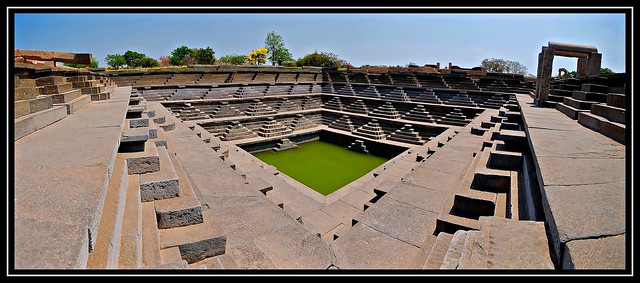
Stepped Tank, Royal center Hampi
One of the main branches of this aqueduct supplied water to the geometrically thrilling Stepped Tank within this area. In fact the very discovery of the Stepped Tank was due to this branch of aqueduct leading to particularly nowhere. The archeologists dug the ground at its end point and the tank emerged.
Radically different from the rest of tank constructions in Hampi, the Stepped Tank is made of made of finely finished black schist stone blocks. It seems the tank was made elsewhere and later brought and assembled at its current location. Practically every stone is earmarked for this purpose and some bears even 'sketches' by its architects. The purpose of this tank is not very sure, mostly it was used during the religious ceremonies by the royals.

Mahanavami Dibba Panorama
Panoramic View of the Royal Center atop Mahanavami Dibba
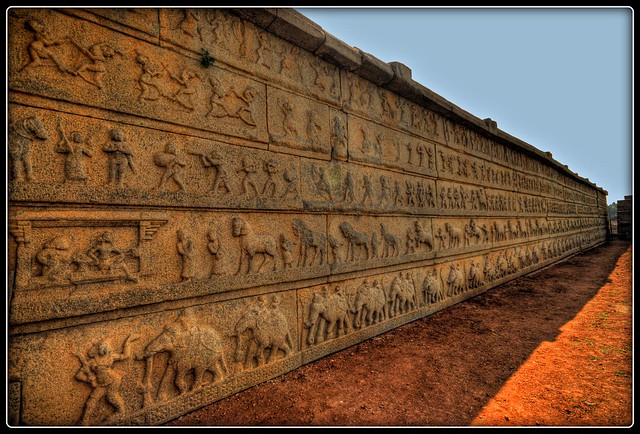
Hazara Rama Temple Wall Carving, Hampi
The first thing comes to mind on seeing this temple, or more precisely its walls, is the locally popular comic strips of Hindu mythology, Ramayana. But the difference is, the stories are carved, in long arrays, onto the walls of this temple.
This is not a huge temple by Hampi’s yardstick. But this temple at the heart of the royal area has some peculiarities. Firstly it had been functioning as a private temple for the king, or at the most, the royal family. The importance of this temple can be judged from its nodal location in the royal area. Your paths to various locations within the citadel concur at a corner of this temple.
Probably this is the only temple in the capital with its external walls decorated with bas-reliefs mentioned above. And the temple got its name Hazara Rama (a thousand Rama) Temple owing to this multitude of these Ramayana panels on its walls.
A sprawling lawn located at the north of this temple is an easy landmark you can spot from a distance. The dusty path that connects the Royal Enclosure with the Zenena Enclosure passes along the temple courtyard. Also the path from Danaik’s Enclosure and Underground Shiva Temple joins this path at its northeastern corner.
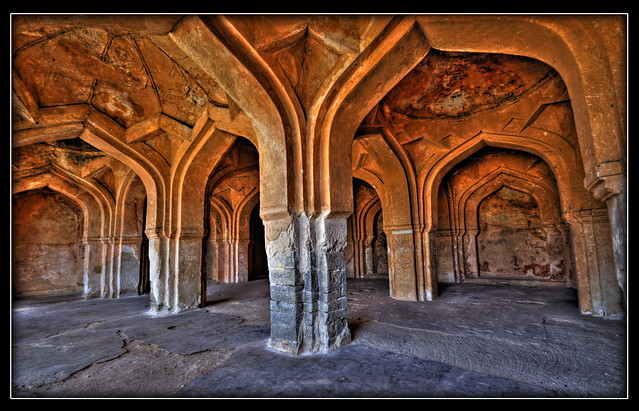
Mosque Arches, Islamic Quarters, Royal Centre Hampi
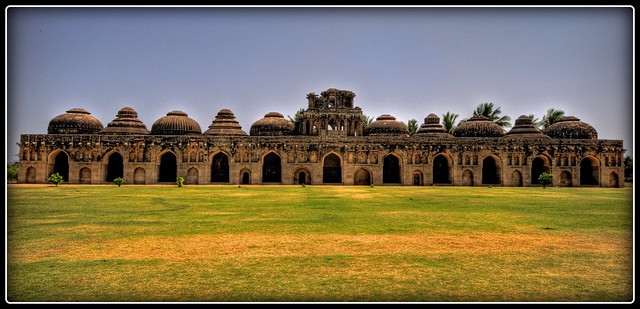
Elephant Stables, Hampi
One among the few least destroyed structures in Hampi, Elephant Stable is a major tourist attraction. This long building with a row of domed chambers was used to ‘park’ the royal elephants. There are 11 domed tall chambers; some of them are inter- connected. The center one is specially decorated and big. Probably the musicians and the associated band troupes had been using this during ceremonies involving elephant processions.
The whole building looks symmetric with respect to this central hall. The tower of the central hall resembles (though mostly destroyed) more like that of temples. However the five pairs of domes on either side are of Islamic in style. They are better preserved and of alternating patterns.
Metal hooks (used to tie the elephants) on the inside roof can be seen. At the rear of each hall are small manhole type openings for the mahouts to enter the elephant compartments. You reach here through the Zenana Enclosure. From here you proceed to the Guard’s Quarters and then may be to the Ranga Temple located a bit south of it all.
| The Ultimate Self Realization Course (tm) | | |
| Special New Release--Hear It Right Now!! | Special Announcements!
| See Sankarshan Prabhu's | |
| Get Krishna's Special Mercy by Rendering Devotional Service If you'd like to contribute something to help cover the expenses of Sankarshan Prabhu's European Lecture Series you can | On the order of his spiritual master, Srila Prabhupada, Sankarshan Prabhu has dedicated his life for the most urgent work of spreading Krishna consciousness all over the world. The more that Krishna consciousness spreads, the more that the suffering, scarcity, and hate on this planet will be replaced with bliss, abundance and love. This is a golden opportunity for us to do the highest good for all living beings and receive the special blessings of the Lord. Therefore we should, as much as possible, sacrifice our time, energy, and resources to assist Sankarshan Prabhu in his most important work. If you would like to help out to any extent, little or big, kindly inform Sankarshan Prabhu of your desire. | Meet If you would like to meet Sankarshan Prabhu or hear his lectures, you may contact us directly for an appointment or specific information on where and when his lectures will be held. | |
| Do You Have Questions or Need Guidance? | All inquiries are welcome. | Contact Information: Phone: 1-512-835-2121 or Email your questions |

 Sri Krishna Janmastami
Sri Krishna Janmastami Maha Kalash Abhisekha
Annual Patron Member Puja You are cordially invited to sponsor a Golden Kalash to bathe Sri Sri Radha Krishna, on the most auspicious day of
Sri Krishna Janmastami
(September 4, 2007)
This is a wonderful chance for you and your family to sponsor a beautiful bathing ceremony for Sri Sri Radha and Krishna. With your generous sponsorship, you will get to keep the sacred Kalash that the temple priest uses to bathe the Lord on your behalf. We will mail you your golden Kalash along with a wonderful assortment of prasadam sweets that will be offered to Sri Sri Radha Krishna on Janmastami. Your tax deductible contribution with help us to maintain and develop the worship of Lord Krishna.
Your golden Kalash is an amazingly beautiful transcendental work of art that your family will treasure for many generations. It will be shipped to you in a red velvet box as seen above:
There is a very limited supply. So if you would like to to sponsor a Kalash, do so right away before they are all taken: www.backtohome.com/KalashToday's Thought - December 2005
Today's Thought - November 2005
Today's Thought - October 2005


TABLA - FUENTES - FONTS
SOUV2
- SOUV2P.TTF - 57 KB
- SOUV2I.TTF - 59 KB
- SOUV2B.TTF - 56 KB
- SOUV2T.TTF - 56 KB
- bai_____.ttf - 46 KB
- babi____.ttf - 47 KB
- bab_____.ttf - 45 KB
- balaram_.ttf - 45 KB
- SCAGRG__.TTF - 73 KB
- SCAGI__.TTF - 71 KB
- SCAGB__.TTF - 68 KB
- inbenr11.ttf - 64 KB
- inbeno11.ttf - 12 KB
- inbeni11.ttf - 12 KB
- inbenb11.ttf - 66 KB
- indevr20.ttf - 53 KB
- Greek font: BibliaLS Normal
- Greek font: BibliaLS Bold
- Greek font: BibliaLS Bold Italic
- Greek font: BibliaLS Italic
- Hebrew font: Ezra SIL
- Hebrew font: Ezra SIL SR
Disculpen las Molestias

Sankarshan Das Adhikari - ANUAL
Conceptos Hinduistas (1428)SC
Aa-Anc · Aga - Ahy · Ai - Akshay · Akshe - Amshum · Ana - Ancie · Ang - Asvayu · Ata - Az · Baa-Baz · Be-Bhak · Bhal-Bu · C · Daa-Daz · De · Dha-Dry · Du-Dy · E · F · Gaa-Gayu · Ge-Gy · Ha-He · Hi-Hy · I · J · K · Ka - Kam · Kan - Khatu · Ki - Ko · Kr - Ku · L · M · N · O · P · R · S · Saa-San · Sap-Shy · Si-Sy · Ta - Te · U · V · Ve-Vy · Y · Z
Conceptos Hinduistas (2919) SK
Aa-Ag · Ah-Am · Ana-Anc · And-Anu · Ap-Ar · As-Ax · Ay-Az · Baa-Baq · Bar-Baz · Be-Bhak · Bhal-Bhy · Bo-Bu · Bra · Brh-Bry · Bu-Bz · Caa-Caq · Car-Cay · Ce-Cha · Che-Chi · Cho-Chu · Ci-Cn · Co-Cy · Daa-Dan · Dar-Day · De · Dha- Dny · Do-Dy · Ea-Eo · Ep-Ez · Faa-Fy · Gaa-Gaq · Gar-Gaz · Ge-Gn · Go · Gra-Gy · Haa-Haq · Har-Haz · He-Hindk · Hindu-Histo · Ho-Hy · Ia-Iq · Ir- Is · It-Iy · Jaa- Jaq · Jar-Jay · Je-Jn · Jo-Jy · Kaa-Kaq · Kar-Kaz · Ke-Kh · Ko · Kr · Ku - Kz · Laa-Laq · Lar-Lay · Le-Ln · Lo-Ly · Maa-Mag · Mah · Mai-Maj · Mak-Maq · Mar-Maz · Mb-Mn · Mo-Mz · Naa-Naq · Nar-Naz · Nb-Nn · No-Nz · Oa-Oz · Paa-Paq · Par-Paz · Pe-Ph · Po-Py · Raa-Raq · Rar-Raz · Re-Rn · Ro-Ry · Saa-Sam · San-Sar · Sas-Sg · Sha-Shy · Sia-Sil · Sim-Sn · So - Sq · Sr - St · Su-Sz · Taa-Taq · Tar-Tay · Te-Tn · To-Ty · Ua-Uq · Ur-Us · Vaa-Vaq · Var-Vaz · Ve · Vi-Vn · Vo-Vy · Waa-Wi · Wo-Wy · Yaa-Yav · Ye-Yiy · Yo-Yu · Zaa-Zy





No hay comentarios:
Publicar un comentario